Previous – 15. On His Own Again | Contents | Next – 17. The House That Jack Built
We’re honored to be able to publish Stan Taylor’s Kirby biography here in the state he sent it to us, with only the slightest bit of editing. – Rand Hoppe
KIRBY’S KOSMIC MYSTERY

“A year before Yuri Gagarin orbited the earth, and nine years before Neil Armstrong set foot on the moon, astronomer FRANK DRAKE launched one of the most intriguing space explorations of the millennium. On April 8, 1960, in a windswept valley near Green Bank West Virginia, Drake flipped switches, twisted knobs, and then pointed an 85-foot radio telescope at two nearby stars- Epsilon Eridani, and Tau Ceti. His aim: to listen for signs of communication technology emanating from a civilization beyond Earth.”
So begins the web page introduction of SETI-The Search for Extraterrestrial Intelligence began that cold and lonely day back in 1960. Dr. Drake’s research and life long dream became a part of the pop culture in 1985, thanks to Dr. Carl Sagan’s fictional book CONTACT, and the subsequent 1997 movie, starring Jodie Foster.
In the story, Sagan tells of an eccentric, combative scientist, endlessly searching the skies for some sign of extra-terrestrial intelligence. When apparent contact is made, the scientist must convince a doubting scientific and military community. Finally convincing the authorities that an alien intelligence has initiated contact, the go ahead is given for an attempt at a rendezvous. The scientist is launched and apparently makes contact with an alien life force, but upon returning to Earth, must face a disbelieving, and skeptical world.
So what does Jack Kirby have to do with this, and why any great mystery? In what might be the strangest case of Kirby’s prognostication wizardry, he beat Dr. Drake to the punch in starting SETI, and he wrote Dr. Sagan’s story 25 years earlier.
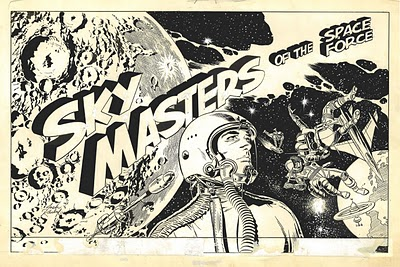
Jack Kirby and the master Wallace Wood
The mystery begins in late 1958, Jack Kirby is hired to draw the syndicated strip SKY MASTERS of the SPACE FORCE. The strip, to be written by brothers, Dick and Dave Wood, penciled by Kirby and inked by the master, Wally Wood. The strip was noteworthy primarily for the authenticity and technical assistance provided by NASA. As time went on, the Wood Bros. had less and less to do with the scripting, until the storytelling became completely Kirby’s.


First in 1937 who knew?
On March 18th, 1960, towards the end of the run, a storyline began that would run thru July 6, 1960. This storyline entitled “Message From Space” begins with Sky Masters being introduced to Dr. Martin Strickland, an eccentric loner scientist who has gone off to a remote part of the country to conduct his own research. The research involves using a radio telescope to listen to cosmic garble for signs of intelligent life from outer space. As Dr. Strickland tells Sky “I’ve discovered a definite pattern— a repetition of sounds—“Sky responds hesitantly “You mean…you’ve received signals by radio telescope from outer space?” To which the Dr. answers “More than that Sky! If I’m right, thinking creatures have sent us a message from out there!”
The message that the Dr. has received comes from the star Tau Ceti, and the message contains the location for “rendezvous”. Sky asks Marty why he has kept this message a secret. Marty replies;” Sky….what does history tell us happens to humans when one strange culture comes in contact with another? …They battle each other, Sky! Do we dare rendezvous with an unknown culture without knowing positively they are not hostile?” If I had one reason strong enough to warrant risking contact with a possible hostile culture, Sky.” To which Sky replies; I have one…If we don’t accept the challenge, Marty, we’ll be like wild animals forever listening in a space jungle afraid of ever replying to each other.” “Of course! Let’s head for the Cape.” Strickland answers.
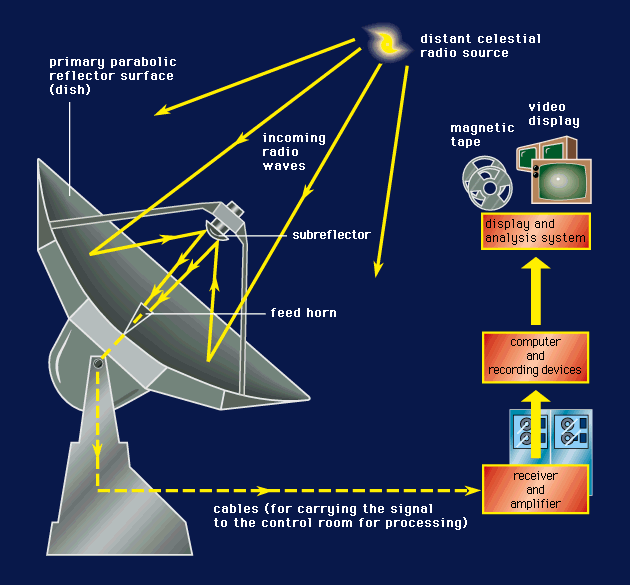
Basics of a radio telescope
After a contentious and at times, quite philosophical debate, among and between the scientific and military communities, it is decided that Dr. Strickland will attempt contact, on a ship piloted by Sky Masters. Once in orbit, they begin receiving more signals from space, then a new blip appears on their radar, a space craft hovering a million miles away. Again Strickland’s wariness intrudes and Sky comes up with an idea to bluff the aliens into thinking we are more advanced than we are. They will bounce a signal off the moon to give the impression that we are colonizers. After receiving the bounced message, the aliens release an atomic bomb that explodes harmlessly in space. After debating the nature of the explosion, Sky surmises that it was a thermonuclear handshake across space, and they rig their own nuclear blast in response. After the return blast, the alien ship moves away, and Sky pilots his ship home. When they make their report about the alien encounter, they are met with skepticism and doubt over what they observed, one scientist responds “The country’s full of irresponsible eccentrics who would squander a king’s ransom searching for space people…” “You have no actual proof of another intelligent life in space.” And the story ends with Dr Strickland, in a huff, taking his charts and graphs and retiring to his island to find a way to decode the blips and to send intelligent messages back to Tau Ceti.
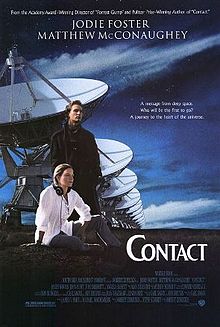
This is some of the most ambitious storytelling Kirby had ever done, full of plot twists, personality conflicts, and deeper philosophical contemplations than ever seen in his comic book work. The detail and technical aspects are amazing.
After reading the story, I was of course struck by the many similarities with the Sagan book. The details surrounding Dr. Strickland’s research, and the actual SETI program was too coincidental, and I first assumed that SETI research must have been well known at the time that Kirby wrote the story. But, being the stickler for facts that I am, I decided to verify, and this is where it got weird!!!!
From the web site mentioned above, I found out that the first SETI project, Project Ozma, did not begin until April of 1960, more than 2 months after Jack Kirby began drawing the story – as verified by then inker Dick Ayers, whose records indicate that he began inking the first days strip at the beginning of Feb. 1960. This first project, run by an eccentric loner, Dr. Drake, in an isolated corner of this country, involved using a radio telescope, targeted on the star Tau Ceti !!!!
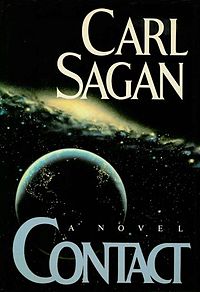
Science or God
The more I read about the SETI program, the more coincidences I found, so my assumption was that somehow, either through the project’s public relations, or possibly Kirby’s NASA contacts, Jack had gotten wind about the project and quickly came up with the storyline, in an attempt at making Sky Masters as topical as possible. Yet something didn’t fit, even if Kirby did have knowledge of Project Ozma, this doesn’t explain just how similar Kirby’s storyline was to Sagan’s. So I took a chance and contacted Dr. Drake. Surfing through SETI’s maze of e-mails, I finally tracked down Dr. Drake. I wrote and explained my findings, hoping that he could explain how Jack Kirby could have known about these items prior to the actual experiment. In a series of exchanges, (excerpted here) he answered some of my questions, and frankly, left me with even more.


Dr. Drake
I wrote:
Dear Dr. Drake,
I have gotten your name via the SETI Inst. Home page, I apologize for any inconvenience, but I have come across a mystery involving your initial research, and am hoping you could provide some answers.
In the months directly preceding your Project Ozma, a nationally syndicated newspaper strip called SKY MASTERS OF THE SPACE FORCE, was running a story about an eccentric astronomer who had been doing SETI style research, and had made contact with an unknown intelligence source. The many coincidences between the strip, and your work is astounding: Using a radio telescope to listen to background space garble, pinpointing Tau Ceti as the source, even the central figure, Dr. Martin Strickland bears a physical resemblance to you. Your formula quantifying extraterrestrial possibility is referred to in a passing manner. This raises some questions I hope you can shed some light on.
Dr. Drake responded;
Dear Mr. Taylor,
Thanks for your interesting message. I have no recollection whatsoever of the “Sky Masters” strip or any comic connection to Project Ozma. Perhaps it was because I was then living in West Virginia and the only newspaper available had almost no comics in it.
Question: Was your research project widely known so that a comic strip writer would have this type of specific knowledge prior to the April 8th 1960 date?
Answer: No. There was little public mention of the project in late 1959. I am surprised that anyone was writing about radio contact with ET’s at that time. It certainly was not an idea that popped up anywhere in the media of the time.
Question: Did you release any public statements announcing your research?
Answer: No, none, we kept a very low profile.
Question: Was NASA involved with your research, I ask this because the artist/writer, Jack Kirby did get technical assistance from NASA for his strip?
Answer: No, there was no NASA involvement at all in Project Ozma, or in any SETI work for many years thereafter. The NRAO, (National Radio Astronomy Observatory) was sponsored by the National Science Foundation, but no one from there was involved either.
Question: Did you know Jack Kirby?
Answer: No, this is a new name to me.
Question: Or Dave Wood?
Answer: The name Dave Wood means nothing to me.
Question: Has this strip (Sky Masters) ever been talked about? In the SETI newsletter, or any writings by yourself or others?
Answer: No, none of us has ever been aware of it
Question: The story in the strip takes the research to a similar conclusion that Dr. Sagan did in “Contact”, even going so far as having the unknown source supply a rendezvous point, and initiating contact, and an equivocating ending with no verifiable contact between the two cultures. Do you know if Dr. Sagan ever referred to this comic strip in passing?
Answer: I am pretty sure that Dr. Sagan knew nothing of this strip. He never mentioned it to me, and he probably would have had he known about it.
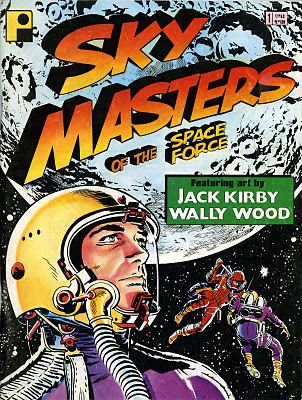
Greg Theakston’s graphic collection
That pretty much was the extent of our communications, I thanked him for his patience and assistance, and I promised that I would get him a copy of Greg Theakston’s Sky Masters book. (My thanks to the people at Pure Imaginations, especially Richard Bensam for supplying a copy at no cost)
I did manage to find a small article in Time Magazine from late Nov. 1959 that mentions Dr. Drake and his soon to be attempted experiment, but this article lacked the details and similarities between Kirby’s story and Sagan’s. Unfortunately, both men are gone, and can shed no light on the subject. Perhaps it is simply a case of cosmic equipoise, or the subliminal residue from Sagan reading Jack’s strip 25 years earlier. For myself, I choose to consider it a case of great minds thinking alike.
Kirby knew science, and science fiction. He voraciously read novels and sci-fi pulps, and was kept up to date by his friends at NASA; Neal explains;
“Dad was a member of the Science Fiction Book Club,(started in 1953) so robots and aliens and tales of the future abounded. How did he actually have time to read? I have no idea, but the Dungeon collection was no ornamental library; he had read every book and probably more than twice.
Sagan’s book postulates one of the great unanswered realities; Answering a question from the child version of the main character, her father says; “The universe is a pretty big place. It’s bigger than anything anyone has ever dreamed of before. So if it’s just us…seems like an awful waste of space.” I think Jack Kirby understood and accepted this concept, and soon populated his world with Krees, Skrulls, Insecticons, Galactus’ and dozens of other alien forms from outside the galaxy; both good and bad. This concept became perhaps the single most quest of Kirby’s fictional life. Jack Kirby saw both the traders, and the tigers.
Soon after the Sky Masters tale, Kirby drew a monster story for Atlas named Sserpo-the Creature that Crushed the World. The story revolved around another scientist doing SETI style research and uses his radio telescope to contact an alien society for help. This story appeared in Amazing Adventures #6 (Nov. 1961)
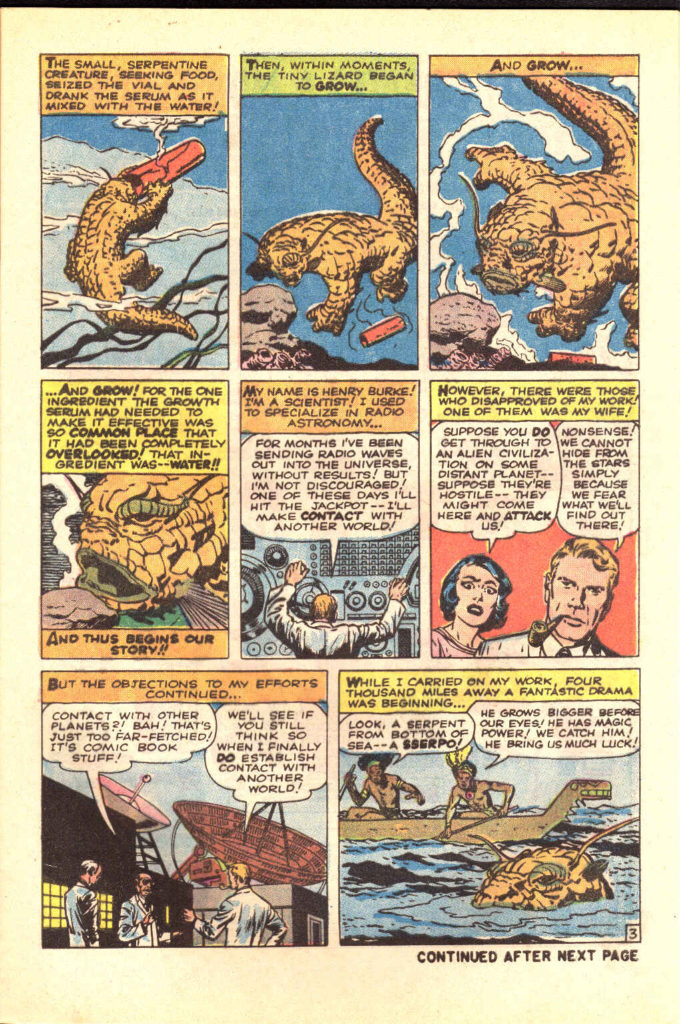
Kirby reusing the radio telescope bit with the same philosophical fear.
Another connection would occur many years later when Jack Kirby was asked by a magazine for his ideas for the Jupiter Plaque. This was a plaque devised by Carl Sagan to be sent into space to introduce humanity to any alien civilization that might one day come across it. Ever the philosopher, Jack explained that he was wary about sending an invite to aliens, because we don’t know who would answer, “the trader or the tiger”. So Jack’s response was a picture of man as happy superheroes, friendly, but able to protect themselves against invaders, still bluffing our way into space. Jack used this bluff many times in his Atlas monster tales, and in Fantastic Four #2 when he sent clippings of Atlas monsters to scare the Skrull Empire into believing Earth inhabitants were too powerful.

more sentient robot stories
Kirby’s time with Sky Masters wasn’t solitary. He spent a lot of time preparing other strips to sell to the syndicates. None seem to have caught on despite the help of the cream of the comic inkers. Chip Hardy was especially interesting as Kirby added in many sci-fi elements. Some that would be used again later.

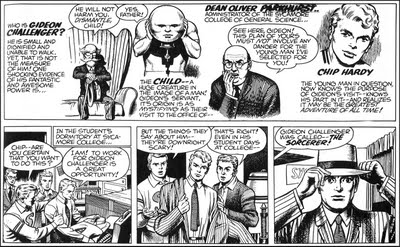

Many titles and many presentations, the inkers were a mix of giants; Wood, Giella, Giacoia, Elder.
Previous – 15. On His Own Again | top | Next – 17. The House That Jack Built

